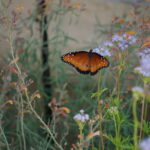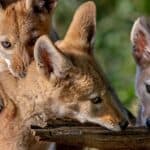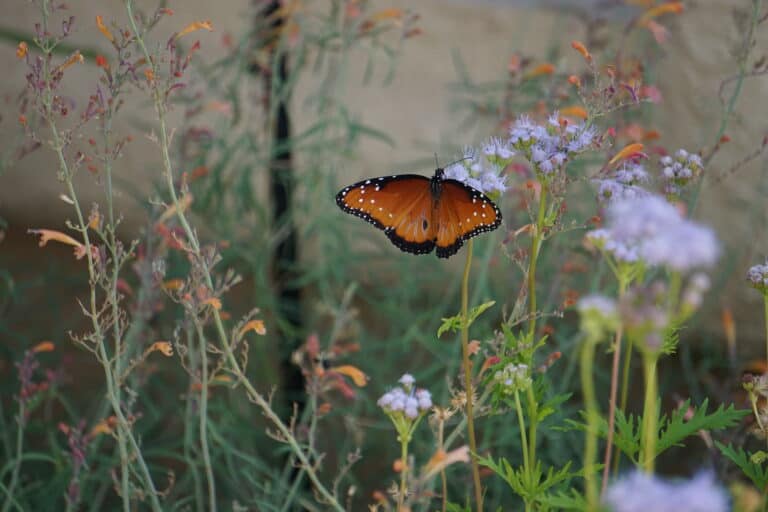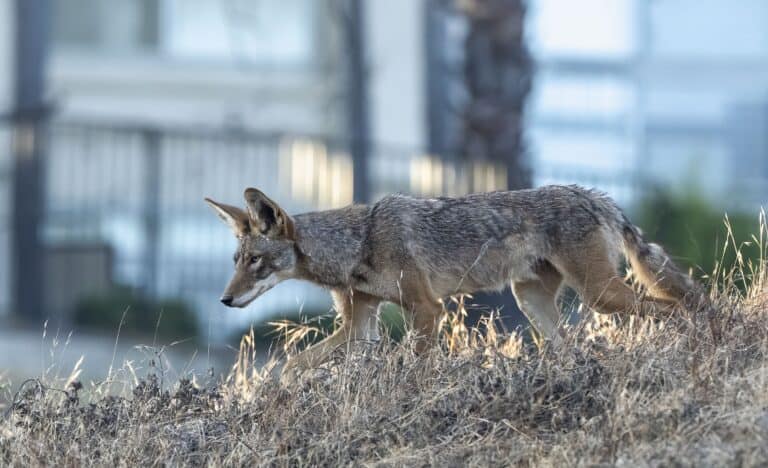Notes From The Field Blog By Sarah Gorsline, Project Coyote Vermont State Representative & MultiMedia Associate
Not long ago I returned to the Green Mountain State, also known as Vermont, where I grew up visiting the house of my Great Aunt, previously shared with my Grandmother who I never had the chance to meet, in a small town in Windsor County. I remember my Great Aunt, an elder in her eighties loading logs into her woodstove with one hand on cold winter mornings, and the way she wandered and touched the peonies and hollyhocks in her tumbling garden near the large porch we sat on looking toward a pond where my dad fished as a kid. My family has roots in Vermont dating back more than a century, some lanes and byways still hold family names. The steep rock faces, the purple layers of foothills against taller blueish mountains, the swathes of wild deciduous forest and rushing clear creeks, are familiar to me, fundamental building blocks of what I grew up inhaling as my father drove us along the rural roads to Windsor County.
Now as a Vermont State Representative for Project Coyote, along with my colleague Chris Schadler, the New Hampshire State Representative and wild canid specialist, and under the supervision of Project Coyote’s Carnivore Conservation Director Renee Seacor, I’m helping fellow wildlife advocates push forward the campaign for coexistence with wild carnivores throughout Vermont and the Northeast. I hope my ancestors would be proud of my efforts, in the same way that I admired their fundamental love of the land, and their interest in social justice.
Our critical carnivore community members in Vermont include the Eastern coyote, Eastern wolves who have been found dispersing into the region since the late 1990’s, black bears, bobcats, fishers (a large weasel relative), red and gray foxes, and the rare lynx. These Ecosystem Allies fill the historic role that Eastern wolves and cougars once held, before being extirpated. The work of wildlife advocates in Vermont also extends to other critical allies in ecosystem health like beavers, birds, raccoons, skunks, opossums, turtles and amphibians, and the land and water that supports this diverse life. It’s exciting that in the course of my parents’ lifetimes, coyotes have returned to Vermont and the Northeast from the West.
My late Grandmother and Great Aunt were born in a time when wolves were headed toward becoming functionally extinct in the United States, and if they were alive today they would see the return of Eastern wolves to Vermont landscapes, which to some is a startling development. But these shifting movements of canid species around the United States are not the characteristics of “invasive species,” instead these movements reflect changing values in human society, evolution in how humans interact with their life-sustaining surroundings, and the innate intelligence in nonhuman species to adapt to human behavior.

Two Eastern coyotes | photo by Richard Ennis, Vermont photographer
Like many places, the biggest challenge Vermont wildlife advocates face is a resistance to changing the status quo. Issues I’m actively working to change on behalf of Project Coyote and our Vermont constituents include: a year-round coyote hunting season and limited reporting requirements for large canids killed; hound hunting of wild carnivores including coyotes, bears and bobcats; wildlife killing contests for wildlife other than coyotes (coyote killing contests were banned in Vermont in 2018); bait used in various forms of hunting; and trapping of wildlife, which leads to accidental trappings of companion animals and non-target species in Vermont each year, along with unknown amounts of collateral damage to our wildlife and ecosystems.
And like other states, Vermont has a Fish & Wildlife Department with a rulemaking Board that seems stuck in a traditionalist past, whose rule-making responds to the interests of hunters, trappers and anglers, but which has limited interest in the viewpoints of independent scientists, ecosystem experts, and wildlife advocates and their concerns. Research by the Department on “furbearing species” still involves collaboration with trappers and hunters, who supply carcasses to sample. Innovative techniques to study wildlife while alive are slow to be adopted, with limited funding, and an entrenched culture that maintains past research techniques. Relatively relaxed gun laws in Vermont also affect wildlife advocacy. And like many places around the United States, it can feel like we’re living in a time of cultural civil war.
Nonviolence, which I was lucky to encounter in my editing work on the 45-minute film The Third Harmony: Nonviolence and the New Story of Human Nature for Metta Center for Nonviolence charts a path forward here. Mutual respect and curiosity toward those with opposing viewpoints, differing stakes in the situation, and being able to put on a different set of shoes to continue dialogue, is essential. Getting to know the concerns of an opponent, so as to better speak to those concerns, whether economic, cultural or otherwise, is a key part of any advocacy work. The concepts of Obstructive Program (resistance to problematic behaviors, practices, institutions) and Constructive Program (building beneficial behaviors, practices and institutions) offer intriguing two-fold possibilities to any activist. Ancient nonviolence teachings from Christ to Buddha, later adopted by Gandhi and then by Dr. Martin Luther King, Jr. and the U.S. Civil Rights Movement leaders have relevant applications in this current politically polarized and conflict-heavy time.
It’s been a challenge to return to this beautiful Green Mountain State, to reintegrate into the character of the Northeast which is sometimes politically progressive, while also culturally conservative. “Tradition” is a word many Northeasterners hang a hat on. Change is the only constant, and the winds of change are rustling leaves in Vermont as they are throughout the United States. Vermont legislators have introduced exciting wildlife bills in recent years, including H.323, a bill to ban coyote and bear hound hunting, H.191/S.111 house and senate bills to ban trapping in the state except for nuisance reasons, H.812 a bill to increase protections for endangered and threatened species in Vermont, and S.258 a critical bill to modernize wildlife governance in Vermont by shifting rulemaking authority from the Board of Fish & Wildlife to the trained scientists at the Department of Fish & Wildlife, and to ban coyote hound hunting and use of bait to hunt coyotes.
In 2022 legislators created several legislative mandates, Act 159 and Act 165, to guide wildlife rulemaking by the Board, to make trapping more safe for the public and humane for animals, to minimize conflicts between hound hunters and residents, and to improve animal welfare. When the Board of Fish & Wildlife proposed new wildlife rules in November 2023 that failed to meet parts of these two legislative mandates, the Legislative Committee on Administrative Rules (LCAR) formally registered 4 objections to the new wildlife rules, a rare and significant step for this committee. Legislators differed with the Board of Fish & Wildlife’s rulemaking, which led to a push for wildlife governance reform when legislators found themselves in the same position as wildlife advocates: having their requests and viewpoints ignored.
Hope can be found beyond differing viewpoints in Constructive Program, the nonviolence concept of actively building the positive, despite the negative. Coexistence farming and community coexistence programs with wild carnivores provide a practical path forward for residents and farmers, and show what coexistence looks like when the rubber meets the road. In May 2023 I assisted at a video shoot in Westminster, VT with my colleague Renee Seacor and cinematographer Kyle Bardwell. Kyle shot interviews with coexistence farmer Liz Shaw of Morse Brook Farm, and Project Coyote’s New Hampshire State Representative Chris Schadler, so that I could produce Farming and Ranching with Wildlife short films as educational tools for farmers and ranchers, with support from the Schwemm Family Foundation and the Volgenau Foundation.
These 3 educational films include: Farming and Ranching with Wildlife: Overview, Farming and Ranching with Wildlife: Guardian Animals, and Farming with Wildlife: Coexistence Strategies for Farming in the Northeast U.S.. Learning how Liz uses her Maremma livestock guardian dogs and strategic electric fence enclosures to protect her sheep and cows, while also allowing movement of wild animals across her farm, was inspiring. Liz has experienced zero livestock loss to predators, and considers her local coyote pack to be helpful allies who remove rodents from her fields, and keep other wild carnivores at bay.
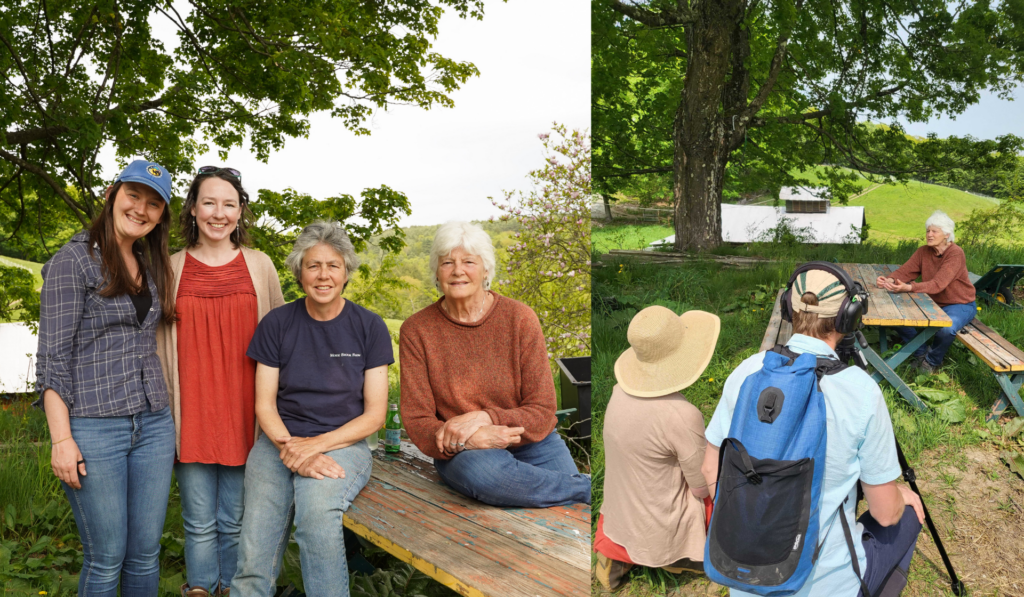
Video shoot for Farming & Ranching with Wildlife videos, from Left to Right: Project Coyote’s Carnivore Conservation Director, Renee Seacor, Sarah Gorsline, Morse Brook Farm coexistence farmer Liz Shaw, Project Coyote’s New Hampshire Representative Chris Schadler | Photos courtesy of Kyle Bardwell and Renee Seacor
Wildlife advocacy is one of the ways I try to practice “tikkun olam” in my life. This Hebrew phrase means “to repair the world” or “to make the world whole.” Born into a family of people who work in medicine, I’ve always admired the healers and repairers of the world, those stitching together the broken pieces, those teaching, caring for, building and encouraging. When I got engaged in wildlife advocacy I was encouraged by how many people emerge from the woodwork to help, whether scientists, citizens or the many wildlife photographers and videographers I have the pleasure to work with in my role as a Multimedia Associate at Project Coyote. I notice how a deep sense of justice and compassion shines in so many hearts, and how we can support each other in this work which is a relay race, not a 20-yard dash. In Vermont I work with a growing coalition of wildlife advocates from Protect Our Wildlife, Animal Wellness Action, Center for a Humane Economy, Vermont Coyote Coexistence Coalition, Green Mountain Animal Defenders, Vermont Wildlife Patrol, In Defense of Animals, Vermont Wildlife Coalition, and students and alumni of Vermont Law School. We get so much more accomplished as a group than we could as individuals.
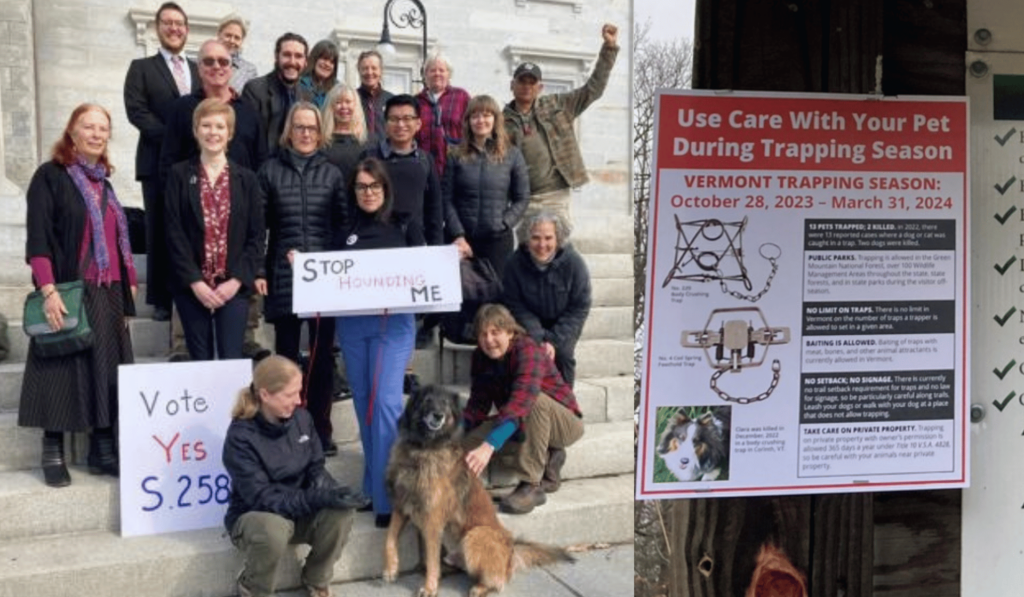
Left Photo: Vermont wildlife advocates at the State House in Montpelier recently, after testimony in support of wildlife governance reform bill S.258 | Photo courtesy of Patti Komline, Animal Wellness Action
Right Photo: An educational flyer created by wildlife advocates to warn pet owners about traps near trails. Anne McKinsey lost her dog Clara (pictured on the flyer) to a body crushing trap in 2022. Sarah Gorsline (author) posted these flyers throughout Northwest Vermont at trailheads and Wildlife Management Areas, in support of residents and their companion animals | Photo courtesy of Sarah Gorsline
Stories are important to how we understand ourselves in the world and our identity. I was a child who was lucky to spend many hours in libraries, enjoying my favorite books like Robert McCloskey’s Blueberries for Sal, Ezra Jack Keats’ Whistle for Willie, Vera B. Williams’ A Chair for My Mother, Anne Grifalconi’s The Village of Round and Square Houses, Jill Barklem’s Brambly Hedge books, and Maurice Sendak’s Outside Over There. Like most children, I loved animals as soon as I was aware of them. I was lucky to have parents who encouraged my experience of nature, and read me stories that led me to question and consider many facets of the natural world. My mother especially is a child of nature, to this day admiring every blossom along our walks, how two trees intertwine in an intimate way, or the chubby squirrel who peers and chucks at her from the neighbor’s fence each morning.
My father remembers my horror when he first read to me Rudyard Kipling’s The White Seal, an unusual story that takes place in the arctic circle, but is found in The Jungle Book. In this story, a young seal learns to navigate the dangers of the world, and in one scene, the seal witnesses the killing and skinning of other seals. Hearing this story as a child was the first time I realized that people harm animals to use their bodies, and the experience was made tangible by experiencing the story through the eyes of a seal. The White Seal led me to many questions, and set me on a path to my current occupation as a video editor who works on mainly documentary projects with a focus on wildlife, the environment, social justice, human health and community building.
The common thread among the stories I heard and the things I learned as a child was the opportunity to place myself into differing viewpoints, experiences and locations, whether human or nonhuman. Not all kids are so lucky. But my hope is that all children, and adults, have the chance to experience different viewpoints through education, outdoors and indoors, and through engaging new ways of seeing the world. Storytelling through video editing is one tool I use to build compassion in the larger community, in my work for Project Coyote that often means revealing the secret lives of wild carnivores, their unique behaviors and habits that remind us of their special family bonds, their love of play, their capacity for feelings, similar to our own experience as humans, and the experience of animals who we consider companions in our homes. In my work with legislators, Fish & Wildlife staff and Board members, and Vermonters with opposing viewpoints, I also use the tools of respect and bridge-building that I learned from the nonviolence community. It is my hope that in continuing to tell unique stories, and reach across differences to find common understanding, that I can help further compassion among humans, and toward wildlife.
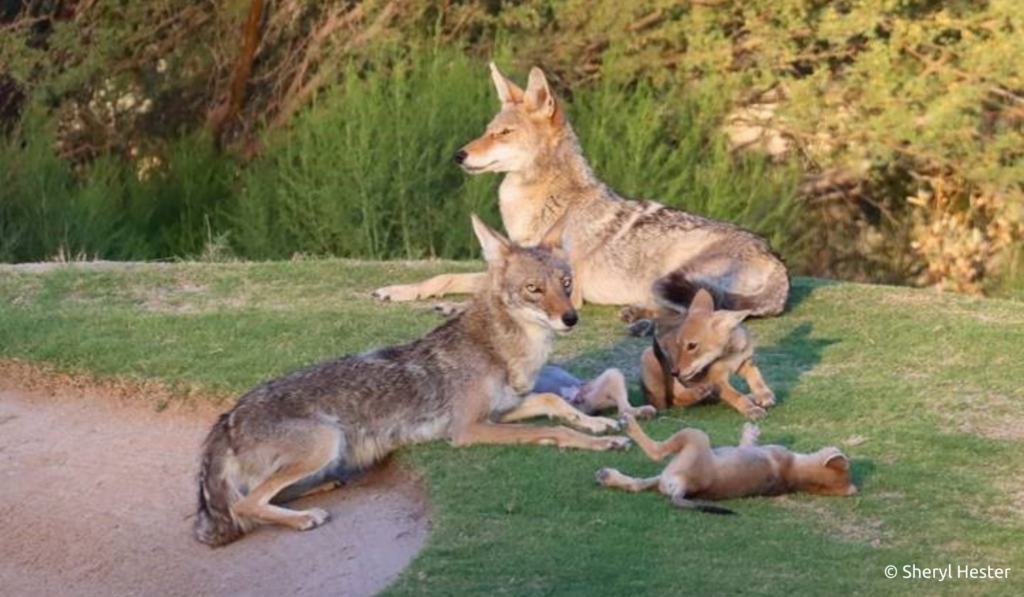
Coyote parents with pups | Photo courtesy of Sheryl Hester
Sarah Gorsline is a Multimedia Associate and the Vermont Representative for Project Coyote, the founder of Sewing Circle Studios, and a freelance video editor and multimedia artist.
.

